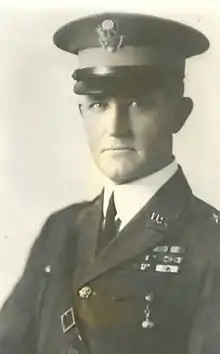William Durward Connor
William Durward Connor (February 22, 1874 – June 16, 1960) was a career United States Army officer who became a superintendent of the United States Military Academy after originally serving in the Corps of Engineers. While stationed in the Philippines, he participated in the Spanish–American War. He later served with the American Expeditionary Forces during World War I.
William Durward Connor | |
|---|---|
 Major General William D. Connor | |
| Born | February 22, 1874 Newark, Wisconsin, US |
| Died | June 16, 1960 (aged 86) Washington, D.C., US |
| Buried | |
| Allegiance | United States of America |
| Service/ | United States Army |
| Years of service | 1897–1938 1941–1942 |
| Rank | Major General |
| Service number | 0-84 |
| Commands held | Superintendent of the United States Military Academy 2nd Infantry Division US Army forces in China American forces in France 63rd Brigade |
| Battles/wars | Spanish–American War World War I World War II |
| Awards | Army Distinguished Service Medal Silver Star (2) Order of the Bath (United Kingdom) Commander of the Legion of Honour (France) Croix de guerre (France) |
Early life and education
Connor, the son of Edward D. Connor and Adeline Powers Connor,[1] was born in Wisconsin on February 22, 1874; according to his 1925 passport application, he was born in the town of Newark, in Rock County. He received an appointment to West Point from Iowa, graduating first in his class in 1897; his Cullum Number is 3742. He received his commission in the Corps of Engineers.[2] Connor graduated from the Army Staff College in 1905 and the Army War College in 1909.[3][4]
Military career
He began his military career as an officer in the Corps of Engineers. During the Spanish–American War, he served in the Philippines as an engineer and was awarded a Silver Star for heroism in combat.[5][6][4]

From 1909 to 1916, he was with the War Department General Staff and was promoted to colonel and appointed Deputy Chief of Staff of the American Expeditionary Forces (AEF) in 1917, following the entry of the United States in World War I in April 1917 (see American entry into World War I). In July 1918, he was promoted brigadier general, and given command of the 63rd Brigade, 32nd Division. He led the brigade at the Battle of Château-Thierry in mid-1918, with his performance resulting in him being awarded a second Silver Star, the citation for which reads:
By direction of the President, under the provisions of the act of Congress approved July 9, 1918 (Bul. No. 43, W.D., 1918), Brigadier General William Durward Connor, United States Army, is cited by the Commanding General, American Expeditionary Forces, for gallantry in action and a silver star may be placed upon the ribbon of the Victory Medals awarded him. Brigadier General Connor distinguished himself by gallantry in action while serving as Commanding General, 63d Infantry Brigade, American Expeditionary Forces, in action near Mont St. Martin, France, 3 August 1918, in personally directing and controlling the attack under severe shell fire.[6]
For his World War I service, he was awarded the Army Distinguished Service Medal. The citation for the medal reads:
The President of the United States of America, authorized by Act of Congress, July 9, 1918, takes pleasure in presenting the Army Distinguished Service Medal to Brigadier General William Durward Connor, United States Army, for exceptionally meritorious and distinguished services to the Government of the United States, in a duty of great responsibility during World War I. As Assistant Chief of Staff and Head of the Coordination Section of the General Staff, American Expeditionary Forces, General Conner showed unusual ability and tireless energy. As Chief of Staff of the 32d Division in the trench operations in the Belfort sector and later as Commander of the 63d Infantry Brigade in the advance to the Vesle he displayed particular ability as a leader of troops. He also performed valuable services as commander of a base port and as Chief of Staff of the Services of Supply.[6]
He also received the Order of the Bath from Britain and from France, he received the Croix de guerre and was named a Commander of the Legion of Honour. After the war he served as commanding general of American forces in France until 1920.[5]
Returning to the United States, Connor served as the Chief of Transportation Service in 1921, Deputy Chief of Staff, US Army, in 1922 and commanding general of US Army forces in China, 1923 to 1926. He was promoted to major general in 1925, serving as commander of the 2nd Infantry Division until 1927, and as commandant of the Army War College until 1932. He served as the Superintendent at West Point from 1932 to 1938.[2][7]
Later life
Connor retired from the US Army on 28 February 1938 but was recalled for service during World War II as Chairman of the Construction Advisory Committee, War Department on May 7, 1941. He remained in that capacity until March 31, 1942, when he reverted to the retired status.[2][8][5] He died at Walter Reed Medical Center.[5] and is buried at the West Point Cemetery, section 18, row G, grave 75.
Notes
- Davis 1998, p. 82.
- "Biographical register of the officers and graduates of the U.S. Military Academy at West Point, N.Y., from its establishment, in 1802 : (Supplement, volume IX 1940-1950)". United States Military Academy Library. 1950. Retrieved 2009-04-04.
- Official Army Register: United States Army Active and Retired Lists. Vol. I. U.S. Government Printing Office. January 1, 1949. p. 647. Retrieved 2022-07-13.
- Venzon 1995, p. 166.
- Davis 1998, pp. 82–83.
- "Valor awards for William Durward Connor".
- Venzon 1995, p. 167.
- Venzon 1995, pp. 166–167.
References
- Davis, Henry Blaine (1998). Generals in Khaki. Pentland Press, Inc. ISBN 1571970886. OCLC 40298151.
- Venzon, Anne Cipriano (1995). The United States in the First World War. London: Routledge. ISBN 0-8153-3353-6.